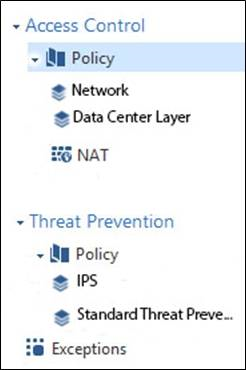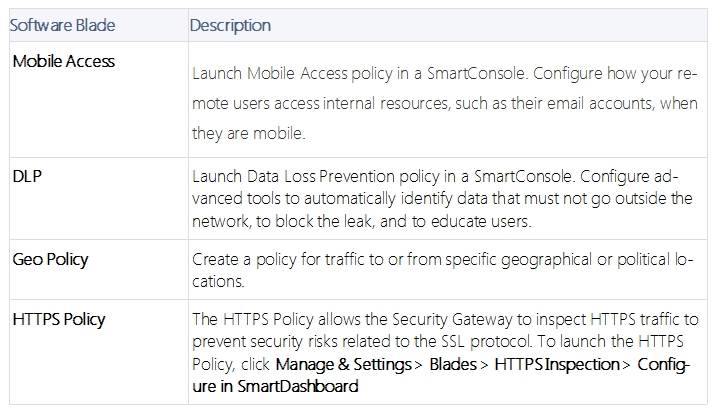File Info
| Exam | Check Point Certified Security Administrator |
| Number | 156-215.80 |
| File Name | Checkpoint.156-215.80.ActualTests.2019-07-16.263q.vcex |
| Size | 7 MB |
| Posted | Jul 16, 2019 |
| Download | Checkpoint.156-215.80.ActualTests.2019-07-16.263q.vcex |
How to open VCEX & EXAM Files?
Files with VCEX & EXAM extensions can be opened by ProfExam Simulator.
Coupon: MASTEREXAM
With discount: 20%





Demo Questions
Question 1
Which of the following is NOT an integral part of VPN communication within a network?
- VPN key
- VPN community
- VPN trust entities
- VPN domain
Correct answer: A
Explanation:
VPN key (to not be confused with pre-shared key that is used for authentication). VPN trust entities, such as a Check Point Internal Certificate Authority (ICA). The ICA is part of the Check Point suite used for creating SIC trusted connection between Security Gateways, authenticating administrators and third party servers. The ICA provides certificates for internal Security Gateways and remote access clients which negotiate the VPN link. VPN Domain - A group of computers and networks connected to a VPN tunnel by one VPN gateway that handles encryption and protects the VPN Domain members. VPN Community - A named collection of VPN domains, each protected by a VPN gateway. Reference:http://sc1.checkpoint.com/documents/R77/CP_R77_VPN_AdminGuide/13868.htm - VPN key (to not be confused with pre-shared key that is used for authentication).
- VPN trust entities, such as a Check Point Internal Certificate Authority (ICA). The ICA is part of the Check Point suite used for creating SIC trusted connection between Security Gateways, authenticating administrators and third party servers. The ICA provides certificates for internal Security Gateways and remote access clients which negotiate the VPN link.
- VPN Domain - A group of computers and networks connected to a VPN tunnel by one VPN gateway that handles encryption and protects the VPN Domain members.
- VPN Community - A named collection of VPN domains, each protected by a VPN gateway.
Reference:
http://sc1.checkpoint.com/documents/R77/CP_R77_VPN_AdminGuide/13868.htm
Question 2

Two administrators Dave and Jon both manage R80 Management as administrators for ABC Corp. Jon logged into the R80 Management and then shortly after Dave logged in to the same server. They are both in the Security Policies view. From the screenshots below, why does Dave not have the rule no.6 in his SmartConsole view even though Jon has it his in his SmartConsole view?

- Jon is currently editing rule no.6 but has Published part of his changes.
- Dave is currently editing rule no.6 and has marked this rule for deletion.
- Dave is currently editing rule no.6 and has deleted it from his Rule Base.
- Jon is currently editing rule no.6 but has not yet Published his changes.
Correct answer: D
Explanation:
When an administrator logs in to the Security Management Server through SmartConsole, a new editing session starts. The changes that the administrator makes during the session are only available to that administrator. Other administrators see a lock icon on object and rules that are being edited. To make changes available to all administrators, and to unlock the objects and rules that are being edited, the administrator must publish the session. Reference: http://dl3.checkpoint.com/paid/74/74d596decb6071a4ee642fbdaae7238f/CP_R80_SecurityManagement_AdminGuide.pdf?HashKey=1479584563_6f823c8ea1514609148aa4fec5425db2&xtn=.pdf When an administrator logs in to the Security Management Server through SmartConsole, a new editing session starts. The changes that the administrator makes during the session are only available to that administrator. Other administrators see a lock icon on object and rules that are being edited. To make changes available to all administrators, and to unlock the objects and rules that are being edited, the administrator must publish the session.
Reference:
http://dl3.checkpoint.com/paid/74/74d596decb6071a4ee642fbdaae7238f/CP_R80_SecurityManagement_AdminGuide.pdf?HashKey=1479584563_6f823c8ea1514609148aa4fec5425db2&xtn=.pdf
Question 3

Review the following screenshot and select the BEST answer.

- Data Center Layer is an inline layer in the Access Control Policy.
- By default all layers are shared with all policies.
- If a connection is dropped in Network Layer, it will not be matched against the rules in Data Center Layer.
- If a connection is accepted in Network-layer, it will not be matched against the rules in Data Center Layer.
Correct answer: C
Question 4
Which of the following is NOT a SecureXL traffic flow?
- Medium Path
- Accelerated Path
- Fast Path
- Slow Path
Correct answer: C
Explanation:
SecureXL is an acceleration solution that maximizes performance of the Firewall and does not compromise security. When SecureXL is enabled on a Security Gateway, some CPU intensive operations are processed by virtualized software instead of the Firewall kernel. The Firewall can inspect and process connections more efficiently and accelerate throughput and connection rates. These are the SecureXL traffic flows:Slow path - Packets and connections that are inspected by the Firewall and are not processed by SecureXL. Accelerated path - Packets and connections that are offloaded to SecureXL and are not processed by the Firewall. Medium path - Packets that require deeper inspection cannot use the accelerated path. It is not necessary for the Firewall to inspect these packets, they can be offloaded and do not use the slow path. For example, packets that are inspected by IPS cannot use the accelerated path and can be offloaded to the IPS PSL (Passive Streaming Library). SecureXL processes these packets more quickly than packets on the slow path. Reference: https://sc1.checkpoint.com/documents/R76/CP_R76_Firewall_WebAdmin/92711.htm SecureXL is an acceleration solution that maximizes performance of the Firewall and does not compromise security. When SecureXL is enabled on a Security Gateway, some CPU intensive operations are processed by virtualized software instead of the Firewall kernel. The Firewall can inspect and process connections more efficiently and accelerate throughput and connection rates. These are the SecureXL traffic flows:
Slow path - Packets and connections that are inspected by the Firewall and are not processed by SecureXL.
Accelerated path - Packets and connections that are offloaded to SecureXL and are not processed by the Firewall.
Medium path - Packets that require deeper inspection cannot use the accelerated path. It is not necessary for the Firewall to inspect these packets, they can be offloaded and do not use the slow path. For example, packets that are inspected by IPS cannot use the accelerated path and can be offloaded to the IPS PSL (Passive Streaming Library). SecureXL processes these packets more quickly than packets on the slow path.
Reference: https://sc1.checkpoint.com/documents/R76/CP_R76_Firewall_WebAdmin/92711.htm
Question 5
Fill in the blanks: VPN gateways authenticate using ___________ and ___________ .
- Passwords; tokens
- Certificates; pre-shared secrets
- Certificates; passwords
- Tokens; pre-shared secrets
Correct answer: B
Explanation:
VPN gateways authenticate using Digital Certificates and Pre-shared secrets. Reference: https://sc1.checkpoint.com/documents/R77/CP_R77_VPN_AdminGuide/85469.htm VPN gateways authenticate using Digital Certificates and Pre-shared secrets.
Reference: https://sc1.checkpoint.com/documents/R77/CP_R77_VPN_AdminGuide/85469.htm
Question 6
In R80 spoofing is defined as a method of:
- Disguising an illegal IP address behind an authorized IP address through Port Address Translation.
- Hiding your firewall from unauthorized users.
- Detecting people using false or wrong authentication logins
- Making packets appear as if they come from an authorized IP address.
Correct answer: D
Explanation:
IP spoofing replaces the untrusted source IP address with a fake, trusted one, to hijack connections to your network. Attackers use IP spoofing to send malware and bots to your protected network, to execute DoS attacks, or to gain unauthorized access. Reference: http://dl3.checkpoint.com/paid/74/74d596decb6071a4ee642fbdaae7238f/CP_R80_SecurityManagement_AdminGuide.pdf?HashKey=1479584563_6f823c8ea1514609148aa4fec5425db2&xtn=.pdf IP spoofing replaces the untrusted source IP address with a fake, trusted one, to hijack connections to your network. Attackers use IP spoofing to send malware and bots to your protected network, to execute DoS attacks, or to gain unauthorized access.
Reference:
http://dl3.checkpoint.com/paid/74/74d596decb6071a4ee642fbdaae7238f/CP_R80_SecurityManagement_AdminGuide.pdf?HashKey=1479584563_6f823c8ea1514609148aa4fec5425db2&xtn=.pdf
Question 7
Which Check Point feature enables application scanning and the detection?
- Application Dictionary
- AppWiki
- Application Library
- CPApp
Correct answer: B
Explanation:
AppWiki Application Classification Library AppWiki enables application scanning and detection of more than 5,000 distinct applications and over 300,000 Web 2.0 widgets including instant messaging, social networking, video streaming, VoIP, games and more. Reference: https://www.checkpoint.com/products/application-control-software-blade/ AppWiki Application Classification Library
AppWiki enables application scanning and detection of more than 5,000 distinct applications and over 300,000 Web 2.0 widgets including instant messaging, social networking, video streaming, VoIP, games and more.
Reference: https://www.checkpoint.com/products/application-control-software-blade/
Question 8

DLP and Geo Policy are examples of what type of Policy?
- Standard Policies
- Shared Policies
- Inspection Policies
- Unified Policies
Correct answer: B
Explanation:
The Shared policies are installed with the Access Control Policy. Reference: https://sc1.checkpoint.com/documents/R80/CP_R80_SecMGMT/html_frameset.htm?topic=documents/R80/CP_R80_SecMGMT/126197 The Shared policies are installed with the Access Control Policy.

Reference: https://sc1.checkpoint.com/documents/R80/CP_R80_SecMGMT/html_frameset.htm?topic=documents/R80/CP_R80_SecMGMT/126197
Question 9

In which deployment is the security management server and Security Gateway installed on the same appliance?
- Bridge Mode
- Remote
- Standalone
- Distributed
Correct answer: C
Explanation:
Installing Standalone Standalone Deployment - The Security Management Server and the Security Gateway are installed on the same computer or appliance. Reference: https://sc1.checkpoint.com/documents/R76/CP_R76_Installation_and_Upgrade_Guide-webAdmin/89230.htm#o98246 Installing Standalone
Standalone Deployment - The Security Management Server and the Security Gateway are installed on the same computer or appliance.

Reference: https://sc1.checkpoint.com/documents/R76/CP_R76_Installation_and_Upgrade_Guide-webAdmin/89230.htm#o98246
Question 10
Fill in the blank: Gaia can be configured using the _______ or ______ .
- Gaia; command line interface
- WebUI; Gaia Interface
- Command line interface; WebUI
- Gaia Interface; GaiaUI
Correct answer: C
Explanation:
Configuring Gaia for the First Time In This Section:Running the First Time Configuration Wizard in WebUI Running the First Time Configuration Wizard in CLI After you install Gaia for the first time, use the First Time Configuration Wizard to configure the system and the Check Point products on it. Reference: https://sc1.checkpoint.com/documents/R77/CP_R77_Gaia_AdminWebAdminGuide/html_frameset.htm?topic=documents/R77/CP_R77_Gaia_AdminWebAdminGuide/112568 Configuring Gaia for the First Time
In This Section:
Running the First Time Configuration Wizard in WebUI
Running the First Time Configuration Wizard in CLI
After you install Gaia for the first time, use the First Time Configuration Wizard to configure the system and the Check Point products on it.
Reference: https://sc1.checkpoint.com/documents/R77/CP_R77_Gaia_AdminWebAdminGuide/html_frameset.htm?topic=documents/R77/CP_R77_Gaia_AdminWebAdminGuide/112568

